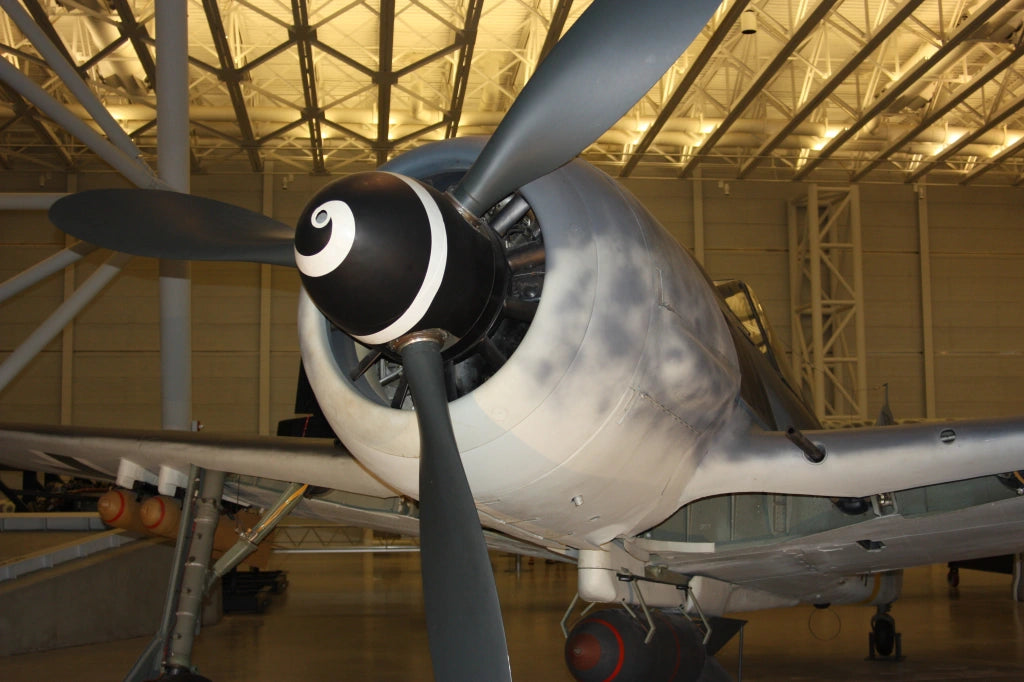Countless dogfights have punctuated the tapestried sky of history, leaving tales of valor and audacity in their wake. Yet, some stories stand apart, not necessarily for the grandiosity of the duel, but for the sheer unpredictability of the combatants’ moves. Such is the dramatic tale of Lieutenant Helmut Bindseil’s audacious maneuver, pitting the propeller of his FW-190 against the formidable P-51 Mustang.
Enter the arena, the European skies of World War II, where the screeching sound of aircraft engines became almost a daily serenade. Among the noises, the Mustang’s engine was distinct. The P-51, an American marvel, was a gleaming symbol of aeronautical prowess. With its Rolls-Royce Merlin engines and streamlined physique, it was no less than an airborne panther, ready to pounce with deadly precision.
In contrast, Bindseil’s trusty steed, the FW-190, often nicknamed “Würger” (the Butcher Bird), bore a more menacing, raw persona. Though it might not match the Mustang’s streamlined elegance, it was a formidable adversary in its own right. Its BMW 801 radial engine promised a growl of resilience, much like an old warhorse, unbowed by the new stallions of the field.
The day these two met in the skies was no ordinary day. As Bindseil and the Mustang’s pilot maneuvered and twisted in this high-altitude waltz, it was clear that this wasn’t just a battle of machines. This was a duel of wits, strategy, and, most importantly, adaptability.
However, as the climax of this aerial ballet neared, Bindseil encountered what every pilot dreads – his guns jammed. A lesser pilot might have seen this as the final act, the curtain call to a tragic end. But Bindseil was not just any pilot. He was an innovator, a thinker, a man who could turn the tide with the cards he was dealt.
And turn the tide he did. In a move that would be talked about in hushed, reverent tones for decades, Bindseil steered his FW-190 dangerously close to the Mustang. Using the momentum and sheer audacity, he let his aircraft’s propeller clip the Mustang. It was a move of unparalleled bravery, one that showcased not the strength of the weapon but the mettle of the man wielding it.
The Mustang, caught off-guard by this unorthodox maneuver, wobbled, losing its once-steady stance in the sky. The damage was done. Bindseil, with his propeller and guile, had secured an unconventional victory.
This tale is not just a testament to Bindseil’s quick thinking but symbolizes a time when battles were as much about the machine as the man behind it. In the vast expanse of the skies, where the room for error was minuscule, the human spirit, more often than not, tipped the scales.
When we reminisce about the past, we should never forget that despite our incredible technological advancements, the raw stories of daring and sheer creativity, much like Bindseil’s, truly stand the test of time. These narratives underscore that a spark of resourcefulness can topple even the mightiest of challenges when backed into a corner.
For more insights into the Focke-Wulf FW 190 and other important military aircraft, visit Aces In Action. Here, you’ll find an amazing piece of artwork by Craig Tinder titled “Yellow 11,” which illustrates a profile of the Focke-Wulf flown by Feldwebel Alfred Bindseil.
Yellow 11 Focke-Wulf FW 190 Aviation Art Print – Profile by Craig Tinder
Based in Stormede, Germany with 6./JG 1, Feldwebel Alfred Bindseil, scored five victories during WWII. In May of 1944, Bindseil claimed an unconventional victory when he used the propeller of his FW-190 to cut the tail off of a P-51 Mustang. Bindseil was later jumped by British Spitfire fighters over France, where he never returned to base. Over 700 allied aircraft of the Western Front and northern occupied Europe were shot down by JG 1 (Jagdgeschwader 1). The unit would eventually become the only Luftwaffe unit to convert to the unique, jet-propelled Heinkel He 162A “Volksjager” fighter. The FW-190 Yellow 11 can be seen at Luftfahrtmuseum Laatzen in Hanover, Germany.






Share:
Bent-Wing Bird: Understanding the Corsair’s Unique Design
Defensive Arsenal: The B-17’s Gun Turrets